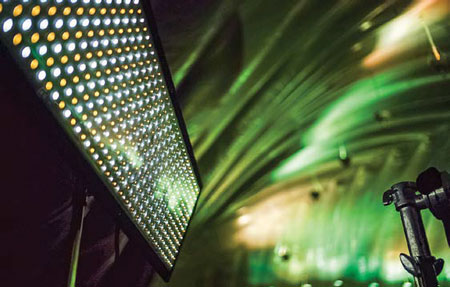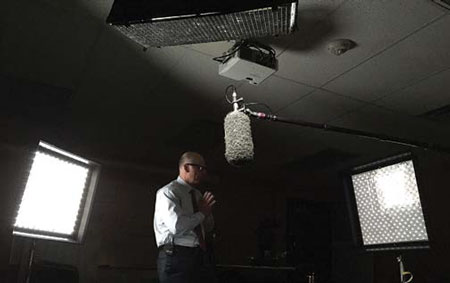Lighting Technology for Today’s Budgets
NEW YORK—Rick Siegel is a New York-based DP with a long career in shooting TV interviews, among his numerous other projects. Despite the fact that we have more choices in cameras in all price ranges than ever before, Rich asserts that “what has remained constant is engaging story telling through my hands on creation of handsome portraiture.”
With this evolution of smaller and faster cameras has come an evolution of field lighting kits as well. So I set out to find shooters and producers interested in talking about the kits that they carry these days.

So much of today’s remote lighting is driven by advances in LED technology which not just produce units with higher CRI but also more uniform response across the spectrum.RUN AND GUN
Rick remembers the days of ISO 100 color negative film with 16mm zoom lens at about f/2.0 moving then to the far less sensitive and far less dynamic range Plumbicon tube cameras. It would not be atypical to carry multiple tungsten fixtures from 200W all the way to 2K.
Today, typical cameras can be rated from ISO 800 and up, with LOG gammas and even RAW (author’s note—few people would actually shoot interviews in RAW; I did it once as more of a “proof of concept” than anything else).
Rick uses what he calls his portable “Cab Kit,” which allows him to mix LED, flo and tungsten, with two Litepanels Astra Bi-Color, one Lowell Rifa 500W, one Arri 125W Fresnel and a couple of 18-inch paper lanterns using standard household bulbs.
“The stands and stingers are the largest component of my lighting kit,” he said, adding that “my only issue mixing LED, florescent, plasma, HMI and/or tungsten lighting units is that they tend to have some differences between each bulb type, especially in the green/pink vectors. Therefore my goal is to keep the interviewee’s key and fill light in the same bulb family.”
BUDGET DRIVEN
Matthew Blute, a cinematographer for Open Road Pictures in Los Angeles, was recently DP for the CNN documentary series “Declassified,” an interview-driven show that included recreations, source material and stock footage, focusing on recently declassified U.S. government cases. Each episode contained three to five interviews, each of which resulted in six hours of raw footage.
Get the TV Tech Newsletter
The professional video industry's #1 source for news, trends and product and tech information. Sign up below.
Matthew’s experience typifies today’s shooting situations which are as much budget-driven as content-driven. It consisted of a crew of two—Matt plus one G/E person hired on each location. They would show up in a hotel room or conference room—or wherever else intelligence agencies might find themselves—with no prior knowledge of room size, logistics, windows or power situation. Shooting was “conversation across the table” style with a Canon C300 shot about six feet from subject with “a wideish lens.” Producers were striving for a “mysterious late afternoon feeling,” he said. “We tried to have a window or daylight source in the frame if possible.” For this ambitious project, Matt went to LiteGear, a new Los Angeles-based LED manufacturer. They used three of their units—LiteMat 2 for edge/kicker/hair light, LightMat 1 for eyelight/above-camera fill as well as a prototype unit 4x4 LightMap (eight 9x19-inch panels hung in a 4x4 breakdown frame). Diffusion was from a magic cloth 4x4 rag from Rag Place in North Hollywood, Calif., in front of an eggcrate. “This gave us a big 4x4 source which was ‘wrappy,’ quick to set up but controlled for 200W and 5-inches thick,” he said. At a distance of eight feet, this enabled shooting the C300 f/8 at ISO 800.
Just for good measure, they carried a Dedo kit for background splashes and highlights. The result? “After shooting thousands of hours of interviews, this was the first time I wasn’t nervous about the size of the space or the power,” Blute said. “It was a real bonus.”

Jeff Halperin owner of ZenVideo, a Phoenix-based high-end production house specializing in 4K (and HD) acquisition, uses LiteMats from LiteGear on-set.TECHNOLOGY ADVANCES
A consistent pattern emerges from shooters and producers: Tighter budgets, smaller crews and less predictability of scenarios is not necessarily a liability. These so-called “constraints” can turn into new creative opportunities. Nobody says “fix it in post” or “let ‘em get a colorist to relight the scene,” anymore. Rather, old school values still remain even in this digital age. Light it properly to create the desired look, choose the tools that fall within not just the budget but physical size for the smaller crew, and creatively rig that lighting.
So much of today’s remote lighting is driven by advances in LED technology which not just produce units with higher CRI but also more uniform response across the spectrum: You don’t necessarily need that magenta gel when shooting today’s LEDs.
But still, the world has not shifted entirely to LED’s.
Like most DPs, Jeff Halperin, owner of ZenVideo in Phoenix, has streamlined his kit over the years. His larger productions might use a rental house or gaffer, but for ENG environments, his choice is LiteGear’s LiteMat 1 which he can power via eternal battery or even AAs. In this scenario, weight is the deciding factor.
But for interviews, he still prefers his Kino-Flo Diva-Lite 200’s and 400’s.
Control of lighting is an important issue, of course. He is awaiting accessories for his LiteMat 4 to enable a much tighter grid, perhaps as tight as 60 degrees, to focus on subject and keep light off the background. He also makes another point about his LiteMats—“they are so thin you can hang them with tape or Velcro and hide them against walls and ceilings,” he said.
These few discussions of approach as well as hardware specifics reinforced much of what I sought to discover when embarking on the quest for today’s location interview, ENG and production lighting packages.
Cameras are indeed faster with far greater dynamic range. We are less concerned about blasting light than shaping light. Larger and well-funded remote production still exists. Mega-produced news and information programming still have the ability to carry and rig what we have come to think of more “traditional” lighting.
But the advent of improved technologies and budget-conscious producers allows leveraging the technology with the creative lighting design of the DP or gaffer.
The bottom line here is not to fear the new realities of economics and technology but rather embrace these changes, to find the right products from acquisition to lighting to light control, and to compelling stories.
Ned Soltz is an industry veteran who shoots, edits, produces and writes about products and industry trends. He also writes for NewBay Media sister publication Digital Video magazine.
